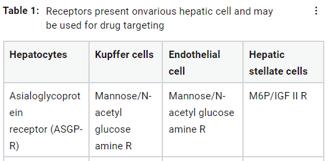Abstract
For metabolic transformation, uptake, detoxification, and excretion liver is the primary organ that is highly equipped. Thus, the liver requires targeting by means like a carrier-mediated mechanism to take xenobiotics into the bile, though high hepatic concentration is achieved by most of the drugs. Thus resulting in high first-pass metabolism displayed by the drugs and thus resulting in rapid clearance of the drugs. Uptake of particulate materials is highly contributed by the kupffer cells largely. However, drug uptake by the liver is highly dependent on hepatocytes. In drug delivery, tissue engineering and regenerative medicines which are various biomedical applications construction of nanoscale based bioactive materials is a desirable approach of selfassembly. By using a targeting moiety, we can decrease the side effects of the drug and increases the therapeutic effect of the drug. Lipoproteins are potential drug carrier to target the organs. Lipoproteins consist of cholesterol, polar lipid core surrounding phospholipid monolayer and apoproteins are embedded in it, and these lipoproteins are spherical. The core is a polar lipid in nature so that highly hydrophobic drugs are easily incorporated into the core. Lipoproteins are completely non-immunogenic, biodegradable nature. The present review should be regularly inspected to beat into the global market at an affordable price as well, particularly the vehicles which are proven to be efficacious in drug delivery systems used to treat liver diseases like cancer.
Full text article
Authors

This work is licensed under a Creative Commons Attribution-NonCommercial-NoDerivatives 4.0 International License.

